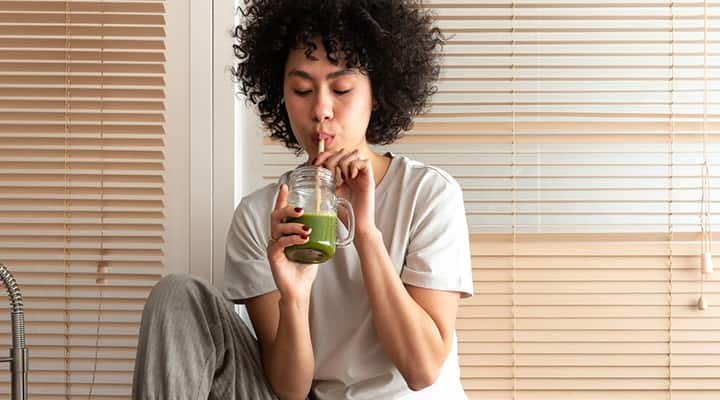
11 High-Protein Vegetables to Add to Your Diet
Published: April 2024
When we think of dietary protein, many of us don't think of vegetables. But certain vegetables pack a hearty, plant-based protein punch.
While plant sources contain less protein per cup than animal sources, they deliver important nutrients that meat doesn't, such as fiber, as well as other key vitamins, minerals and antioxidants.
If you are looking to add more protein to a veggie-heavy diet, a plant-based protein powder is a good starting point. Beyond that, we've got a list of 11 high-protein vegetables to consider adding to your table.
11 vegetables high in protein
These vegetables (which include legumes, leafy and cruciferous vegetables and more) deliver not only protein, but other beneficial nutrients for a well-balanced diet.
1. Chickpeas
Chickpeas, also known as garbanzo beans, are an affordable pantry staple that pack a good amount of plant-based protein, with about 14 grams per cup when cooked. This versatile legume also offers key nutrients, including folate, copper, iron and zinc. Folate is a water-soluble B vitamin especially important for supporting a healthy pregnancy.
Embrace the "half-cup habit," which makes it simple to hit the recommended 1½ cups of legumes weekly by dividing this amount into ½ cup servings three times a week. Besides adding chickpeas to salads or grain bowls, consider using them to make your own creamy hummus recipe that can be paired with sliced veggies and whole grain crackers, or roasting them with oil and seasonings for a crunchy snack.
2. Edamame
Edamame are immature soybeans with about 18 grams of plant protein per cup when raw or cooked, along with fiber, magnesium, calcium and plant-based iron.
Steamed edamame can be eaten right out of the pod, and they are great for tossing into salads, pasta dishes and stir-fries.
3. Lentils
Lentils are another legume nutrition powerhouse. Cooked lentils have about 18 grams of plant-based protein per cup and they deliver fiber, folate and potassium.
Because of their meaty texture, lentils make a great ground beef substitute in spaghetti sauce and make an excellent addition to soup recipes.
4. Black beans
Black beans contain about 15 grams of protein per cup when cooked or canned. Compared to other beans, black beans are richer in anthocyanins, which are antioxidants that help protect your body against oxidative stress.
Versatile black beans can be added to tacos, salads and chili recipes.
5. Lima beans
Lima beans, also known as butter beans because of their creamy texture and sweet flavor, contain about 12 grams of protein per cup when cooked.
Their mild and buttery taste makes them an easy side dish to pair with animal proteins, such as fish and meat, and a delicious addition to soups, salads and dips.
6. Artichokes
Besides delivering about 6 grams of protein per cup when cooked, artichokes contain prebiotics, a type of fiber that helps selectively nourish the good bacteria in the gut, helping to create a balanced and healthy microbiome. Artichokes may also help with occasional bloating.
This spring veggie can be enjoyed both hot and cold.
7. Asparagus
Like artichokes, asparagus is a good source of gut-loving prebiotic fiber. It has about 4 grams of protein per cup when cooked.
The best way to prepare asparagus is to cook it just long enough so it retains its bright green color. Asparagus can be steamed, boiled, stir-fried or grilled. It can also be sliced thinly and enjoyed raw in salads.
Explore Our Best Active Lifestyle & Fitness Supplements
8. Spinach
This dark leafy green vegetable packs a major nutritional punch. Besides containing about 5 grams of protein per cup when cooked, spinach is a source of key nutrients, including vitamin K, folate, fiber and vitamin C.
Enjoy spinach sauteed, raw, steamed or baked. Another way to incorporate spinach is into fruit smoothies. The sweetness of the fruit can help mask any bitterness of the spinach, allowing you to reap its nutrition in a delicious and convenient way.
9. Brussels sprouts
Brussels sprouts fall into the family of cruciferous veggies that also includes broccoli, cauliflower, cabbage, kale and more—all known for their high nutrient content.
Brussels sprouts, when cooked, contain about 4 grams of protein per cup along with vitamin C, vitamin K, fiber and folate. Enjoy Brussels sprouts roasted, steamed or shaved.
10. Broccoli
Broccoli has about 2.5 grams of protein per cup raw and 3.5 grams per cup cooked, in addition to vitamin C, a nutrient important for skin and immune health.
Broccoli and other cruciferous vegetables contain glucosinolates, a group of plant metabolites recognized for their potential health benefits of supporting DNA health and healthy hormone levels.
11. Mushrooms
The meaty texture and flavor of mushrooms sets them apart from other veggies (though they are botanically fungi). With about 2-4 grams of protein per cup, raw or cooked, mushrooms make a great meat substitute in recipes that call for ground beef, such as tacos and spaghetti.
Why is it important to get enough protein in your diet?
Protein is one of three macronutrients essential for human nutrition. Protein is needed to build, repair and maintain muscle mass, promote energy, and maintain bone density and strength. It also supports immune system function, liver function and more.
Added bonus: protein plays a role in healthy weight management thanks to its high satiety value, or that feeling of fullness you get after a meal, which can help reduce your calorie intake.
The recommended dietary allowance (RDA) for protein, or the amount of protein needed to meet your basic nutritional requirements, is a modest 0.8 grams of protein per kilogram of body weight. However, your protein needs vary based on your activity level and overall wellness.
High-quality fitness supplements and plant-based protein powders can help fill in nutrient gaps while promoting satiety, energy and lean muscle mass. But choosing high-protein vegetables is another good way to make sure you are getting enough protein, especially if you follow a vegan or vegetarian diet.
Are plant proteins enough?
Plant proteins can be enough, with a few caveats. It all comes down to the amino acids found in protein. There are 20 amino acids in protein, nine of which are considered "essential." It's been commonly thought by both health professionals and the general population that animal foods are complete protein sources, while most plant foods are not complete sources, meaning they do not contain all nine essential amino acids.
Because of this, many believe their protein needs cannot be supported by plant foods alone. However, recent studies suggest plants contain more amino acids than previously thought, though they may only be present in small amounts.
In fact, the term "incomplete protein sources" is no longer valid, as new research shows that all protein sources contain all 20 amino acids, albeit in varying amounts.
Plant and animal proteins still differ in protein quality, however, because plant-based protein does not contain all 20 amino acids in sufficient proportions. This makes it especially important for those following a plant-based diet to include various protein sources to meet their protein needs.
Vegans and vegetarians should be particularly attuned to the exact breakdown of amino acids in their protein sources. "Limiting amino acid" refers to the specific acid in a protein that is present in the lowest proportion of an individual's dietary requirement. Two most likely to be limiting in plant foods are lysine and methionine. Meals with a variety of plant foods can make up for the limiting amino acids in a single plant protein. These combinations are known as "complementary proteins."
Studies show complementary proteins do not need to be eaten in the same meal to be effective. Eating them together in a 24-hour period conveys the same complementary benefit as eating them together. Either way, you should get to know the amino acids that are in the protein sources you eat so you can ensure you're getting the protein you need to be at your best.
Protein and other nutrients can help support healthy weight management. Our health needs quiz can help you choose a nutrient regimen based on your lifestyle, health status and health goals.
References
- Ferrari L, et al. "Animal- and Plant-Based Protein Sources: A Scoping Review of Human Health Outcomes and Environmental Impact." Nutrients. December 2022. https://www.ncbi.nlm.nih.gov/pmc/articles/PMC9741334/
- "Beans, black, mature seeds, cooked, boiled, without salt." U.S. Department of Agriculture. April 2019. https://fdc.nal.usda.gov/fdc-app.html#/food-details/173735/nutrients
- "Broccoli, cooked, boiled, drained, with salt." U.S. Department of Agriculture. April 2019. https://fdc.nal.usda.gov/fdc-app.html#/food-details/168510/nutrients
- "Broccoli, raw." U.S. Department of Agriculture. December 2019. https://fdc.nal.usda.gov/fdc-app.html#/food-details/747447/nutrients
- "Chickpeas (garbanzo beans, bengal gram), canned, sodium added, drained and rinsed." U.S. Department of Agriculture. October 2023. https://fdc.nal.usda.gov/fdc-app.html#/food-details/2644288/nutrients
- "Legume of the month: Soybeans." Harvard Health Publishing. September 2019. https://www.health.harvard.edu/heart-health/legume-of-the-month-soybeans
- "Protein Foods." MyPlate.gov. U.S. Department of Agriculture. https://www.myplate.gov/eat-healthy/protein-foods
Always be in the know!
Access the latest deals, wellness news, expert health tips & more!











